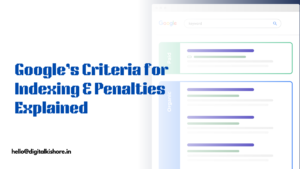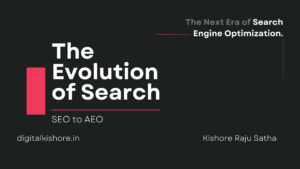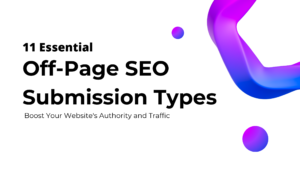As search engines evolve to focus on user intent and immediate answers, the realms of SEO (Search Engine Optimization) and AEO (Answer Engine Optimization) are increasingly important. While both strategies aim to improve visibility and user engagement, they differ in approach and outcome. Here’s an in-depth comparison of SEO and AEO, and how each can benefit your digital presence.

What is SEO?
Search Engine Optimization (SEO) is the process of enhancing website content, structure, and other elements to improve search engine rankings. SEO aims to increase visibility, drive traffic, and boost engagement by optimizing for keywords, backlinks, mobile responsiveness, and page speed.
Key Components of SEO:
- Keyword Optimization: Targeting relevant keywords to match user search queries.
- On-Page SEO: Improving title tags, meta descriptions, headings, and image alt text.
- Technical SEO: Ensuring site speed, mobile-friendliness, and proper indexing.
- Backlinks: Building quality inbound links to establish authority.
- Content Quality: Providing comprehensive and valuable information.
SEO is about enhancing the overall website to rank higher across many keywords, driving organic traffic from various search queries.
What is AEO?
Answer Engine Optimization (AEO) focuses specifically on optimizing content to answer direct user questions. With the rise of voice search and featured snippets, AEO aims to deliver concise, accurate responses in a format that search engines and voice assistants can easily interpret and display.
Key Components of AEO:
- Question-Based Keywords: Targeting queries phrased as questions (e.g., “How to bake a cake?”).
- Featured Snippets: Structuring content to appear as Google’s answer box or “position zero.”
- Schema Markup: Adding structured data to clarify the purpose and content type.
- Concise Answers: Delivering clear, direct responses in 40–50 words where possible.
- User Intent Focus: Meeting the immediate informational needs of users, especially in voice search.
AEO focuses on providing exact answers, often in the form of Q&A content, FAQ pages, or structured snippets that directly fulfill the user’s search intent.

Key Differences Between SEO and AEO
| Aspect | SEO | AEO |
|---|---|---|
| Objective | Drive overall traffic and improve page rankings | Provide immediate answers for question-based queries |
| Focus | Broader visibility across multiple keywords | Direct answers for specific, question-based queries |
| Keyword Strategy | Primarily focuses on keywords and phrases | Focuses on question-based keywords |
| Content Length | Often long-form, in-depth content | Short, concise answers optimized for snippets |
| Technical Elements | Technical SEO, including site speed and mobile-friendliness | Schema markup for rich snippets |
| User Intent | Satisfies broader informational or transactional needs | Targets immediate informational needs |
| Search Medium | Desktop and mobile search | Mobile-first, voice search, and smart assistants |
How SEO and AEO Work Together
While SEO and AEO may seem to serve different goals, they are actually complementary. Here’s how they work together to strengthen your content strategy:
- AEO for Quick Answers, SEO for Detailed Information
- AEO can draw users in by providing direct answers to questions in featured snippets. Once users click through, comprehensive SEO-optimized content provides in-depth information and engagement.
- SEO Optimizes for Visibility, AEO Enhances User Experience
- SEO ensures your content is discoverable across a wide range of searches. AEO, on the other hand, enhances user satisfaction by providing relevant answers, making users more likely to trust your site.
- Voice Search and Mobile Compatibility
- AEO helps you appear in voice search results and mobile searches where users often want quick answers. SEO supports this by optimizing for mobile-friendliness and speed, critical for voice and mobile success.
- Improved Click-Through Rates (CTR) with AEO-Driven Snippets
- By ranking in featured snippets through AEO, your CTR can increase as users see your content immediately answering their queries. SEO further supports this by creating engaging meta descriptions and titles to encourage clicks.
How to Combine SEO and AEO in Your Content Strategy
To maximize both SEO and AEO, consider the following approach:
- Research Both Traditional and Question-Based Keywords
- Identify keywords for traditional SEO (e.g., “cake recipes”) and question-based keywords for AEO (e.g., “How to bake a cake?”). Use tools like Google’s People Also Ask, Answer the Public, and keyword research platforms.
- Optimize for Featured Snippets
- Structure content sections to appear in snippets by using lists, tables, or direct answers to common questions. This can help your content capture the “position zero” spot, driving both visibility and authority.
- Add Schema Markup
- Use schema markup (FAQ, How-to, Q&A) to help search engines understand your content and improve its chances of being displayed as rich results. Schema also boosts your AEO potential, especially for voice search compatibility.
- Focus on User Experience and Intent
- Ensure that your site is fast, mobile-friendly, and organized for easy navigation. Meet user intent by combining SEO-rich content for in-depth information and AEO strategies for direct answers to common questions.
- Create a Q&A Section or FAQ Page
- Add a Q&A or FAQ section to answer common user questions on your site. This not only supports AEO but also drives additional traffic from question-based searches while enhancing overall SEO performance.
When to Prioritize SEO vs. AEO
- If Your Goal is Broad Traffic: Prioritize SEO by optimizing for a range of keywords, building backlinks, and creating in-depth content that draws in a wide audience.
- If Your Goal is Instant Visibility and Brand Authority: Focus on AEO to rank in featured snippets, provide quick answers, and enhance your presence in voice searches.
- For Long-Term Growth: Combine both. Use SEO to build a solid content foundation and AEO to capture specific, high-intent traffic through answer-focused content.
Conclusion: Embrace SEO and AEO for a Holistic Search Strategy
In today’s digital landscape, both SEO and AEO are essential for a well-rounded content strategy. While SEO draws visitors through comprehensive, keyword-rich content, AEO fulfills the need for quick, concise answers – especially on mobile and voice search.
By optimizing for both, you’ll position your site as both a deep source of information and a go-to for quick, trustworthy answers. Embrace the best of both worlds to maximize visibility, boost authority, and meet the evolving expectations of search users.















